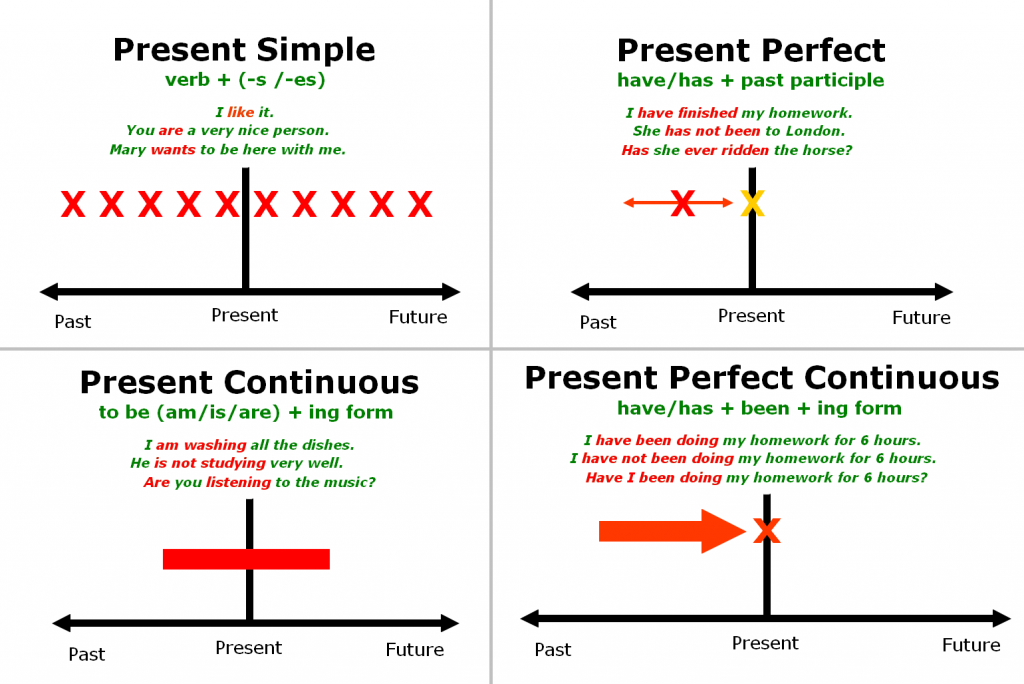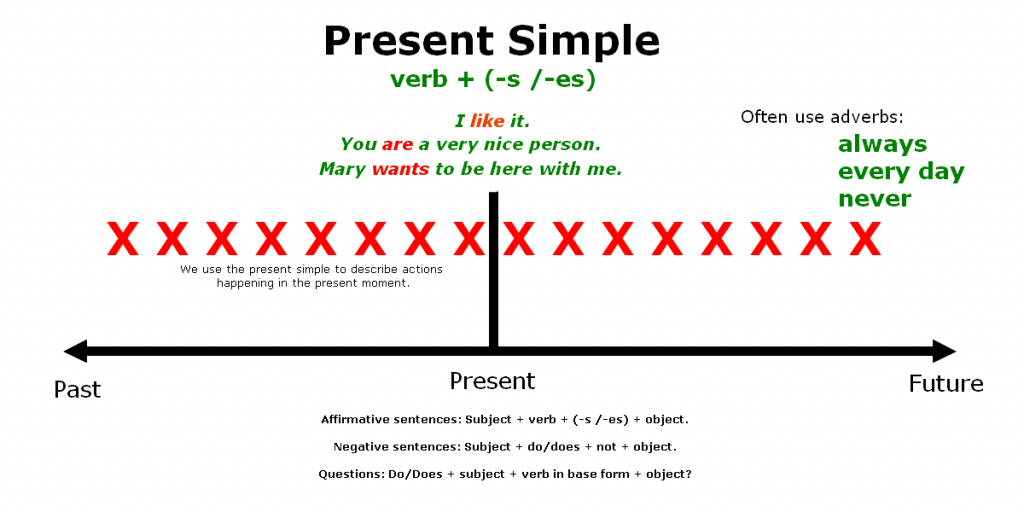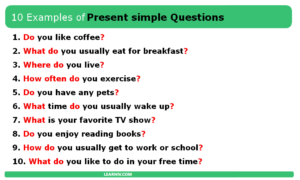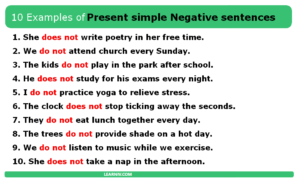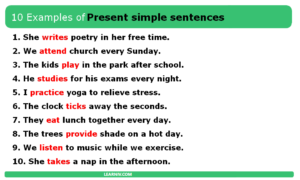The present tense is one of three verb tenses used to describe situations in the present. Sometimes we also use it to talk about future and past activities.
Present tenses use auxiliary verbs, suffixes and special irregular forms of verbs. That’s the reason why we need to learn the present tenses, otherwise we would not be able to construct sentences. There are in general four different present tenses:
It is really important to generally know all the tenses, but the most common and frequently used tense is the present simple. It is used in almost 50% of spoken English, so that’s why we need to at least learn this tense perfectly. Regardless, all of the tenses are important.
All of the present tenses have their own special sentence structures and all of them are used in different situations.
Below is an example that compares all of the present tenses and their different structures:
- Present simple: I play football.
- Present continuous: I’m playing football.
- Present perfect: I have played football.
- Present perfect continuous: I have been playing football.
While all of the sentences use the same verb „play“, they all mean something different.
When do we use the present tenses?
We use the present tenses to talk about actions in the present, but also to describe something in the near future or in the past. We have to look at each tense separately to know when to use them to describe certain events.
Present simple tense
We use the present simple to talk about everyday situations and things that happen regularly. We use this tense to talk about:
Habits and repeated actions
This tense is most commonly used to talk about habits and repeated actions. We very often use adverbs like „usually“, „every day“ or „never“.
- I usually go to the gym on Tuesdays.
- I never eat mushrooms. They are disgusting.
- I go to school every day.
General truth
We use the present simple to talk about general truths. If we want to tell someone an interesting fact, we will use this tense. Such facts are usually timeless and aren’t changed by external influences.
- Did you know that approximately 1.2 million people live in Prague?
- London is the capital city of the UK.
Fixed schedules and arrangements
The present simple is used to talk about fixed schedules, such as bus or school timetables. It can also describe any repeated or unchanging situations, such as those happening every day at the same time.
- The bus leaves at 5:35 PM.
- Our English lesson starts at 10:45 AM.
Feelings or opinions
The present simple is used to talk about feelings and opinions, often by using stative verbs to describe feelings and emotions.
- I love pizza – especially the spinach one.
- I do not like any kind of goat cheese.
Instructions
The present simple is also used in instruction manuals or recipes. It is often used in cooking recipes as well as furniture construction manuals.
- Bring the water to a boil and then add the spaghetti.
- Take out all the screws and make sure you have them all.
Construction of sentences in the present simple
Constructing sentences in the present simple is easy. We just use a verb in its base form with a subject and object. The only thing we need to remember to do is to add the suffix –s/-es to the verb in combination with the subject in the 3rd person singular.
The structure of a sentence in the present simple is:
Subject + verb (s/-es) + object.
Negative
To construct a negative sentence, we simply add the negative „not“ and the auxiliary verb „do“ or „does“ based on the person and subject:
Subject + do/does + not + object.
Question
Questions are similar to affirmative sentences. We just switch the word order.
Do/Does + subject + verb in base form + object?
Example:
- I like potatoes. / She likes potatoes.
- I do not like potatoes. / She does not like potatoes.
- Do I like potatoes? / Does she like potatoes?
Examples of sentences of present simple
Present continuous tense
This tense uses the verb „to be“ plus a verb in its base form with the suffix –ing. We use this tense to talk about actions happening right now, in the present moment. Sometimes we can use this tense to express something that is in progress and is not yet done.
We use the present continuous to talk about:
Actions currently happening
We use the present continuous to talk about actions happening in the present moment.
- I’m reading a book right now.
- She is learning English at the moment.
Fixed arrangements for the future
This tense is used to talk about future events.
- I’m flying to Madrid in June.
- She is getting married next month.
Long lasting events
- We are living in Paris at the moment.
- We are working on this project for a long time.
Complaining about or emphasizing situations
We use this tense to emphasize situations, often using adverbs such as „forever“, „constantly“ or „every time“.
- You are leaving dirty dishes on the table every time!
- They are constantly complaining about something!
Structure of the present continuous
Constructing sentences in the present continuous is easy. The only thing you have to know is to add the suffix – ing to the main verb in its base form and add the auxiliary verb „to be“ after the subject. We must know how to use the verb „to be“ depending on the subject.
The sentence structure is:
Subject + to be (am/is/are) + verb +(-ing) + object.
Am, is or are?
We use the form „am“ to talk about the 1st person singular – it means „I am“. We can also use its short-form „I’m“. The form „is“ is used to talk about the 3rd person singular – it means subjects „He“, „she“ or „it“. We can also use their short-forms, with an apostrophe, „‘s“.
The last form „are“ is used in combination with all the other subjects – „we“, „you“ and „they“. This short-form also includes an apostrophe, „‘re“.
Negative
If we want to construct a negative sentence, we simply add the word „not“ right after the auxiliary verb „to be“. The sentence structure is:
Subject + am/are/is + not + verb(-ing) + object.
Questions
The structure of questions in the present continuous is pretty similar to affirmative sentences:
Am, Are, Is + subject + verb(-ing) + object?
Example:
- I am not / I’m not doing it.
- He is not. / He’s not doing it.
- They are not. / They’re not doing it.
Present perfect tense
This tense is used to connect past events with a present time. The time of the actions is not given – it is unspecified. In the present perfect, we focus more on the result of the action than on the action itself.
We use the present perfect to talk about:
Life experiences during unspecified times in the past
We use the present perfect to talk about life experiences.
- I have flown to Alaska.
- She has swam with crocodiles.
Repeated actions in the past
The present perfect also describes repeated actions in the past.
- We have visited Russia 5 times.
- She has flown to Paris 3 times.
Finished actions with a result in the present
- I have lost my wallet.
- They have eaten raw chicken.
Unspecified times
We use this tense to talk about an action that happened at an unspecified time.
- I have written an article today.
- We have ridden a bicycle this month.
Construction of sentences
To construct an affirmative sentence in the present perfect, we need to know how to use the auxiliary verbs „have“ and „has“.
Form „has“
The form „has“ is used with the 3rd person singular (He, she, it).
- He has ridden a bike.
- She has ridden a bike.
Form „have“
We use this form in combination with all the other persons, except for the 3rd person singular.
- I have ridden a bike.
- They have ridden a bike.
- We have ridden a bike.
The structure of affirmative sentences in the present perfect is:
Subject + have/has + verb in past participle + object.
Negative
To construct a negative sentence, we simply add the negative „not“ and an auxiliary verb right after the verb „have/has“. The rest of the sentence is the same:
Subject + have/has + not + object.
- I have not done this.
Questions
Questions are similar to affirmative sentences. We just switch the word order:
Have/has + subject + verb in base form + object?
- Have you done this?
Present perfect continuous tense
The present perfect continuous is used to talk about events that started in the past and continue at the present time. We know when the action started but do not know if it has finished or not, nor do we care.
The action may still be ongoing or it may have recently finished.
We use the present perfect continuous to talk about:
Actions that started in the past but continue in the present
This tense is commonly and primarily used to talk about actions that started in the past and continue into the present.
- I have been watching The Big Bang theory.
- I have been listening to the Ramstein.
Emphasizing duration of time
This tense is also used to emphasize a duration of time.
- I have been playing the piano since I was 6 years old.
- She has been playing basketball for 5 years.
Finished actions with present results
- It has been raining today. (It is still wet outside)
- We have been painting. (I can still smell the paint in the air)
Construction of sentences in the present perfect continuous
Affirmative sentences in the present perfect continuous include three verbs. The first one is the auxiliary verb „have/has“, the second is the past participle form (3rd form) of the verb „to be“ which is the form „been“, and the last one is the main verb in its base form with the suffix –ing to show the progressive aspect.
The structure of the sentences is:
Subject + have/has + been + verb(-ing) + object.
Negative
To construct a negative sentence, we just add the negative „not“ right after the verb „have/has“. The structure of the sentence is:
Subject + have/has + not + been + verb (-ing) + object.
- She has not been cleaning the bathroom today.
Questions
Questions in the present perfect continuous have the following structure:
Have/has + subject + been + verb (-ing) + object?
- Has she been living in the UK?

